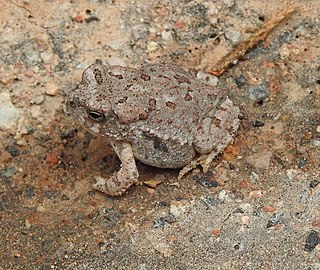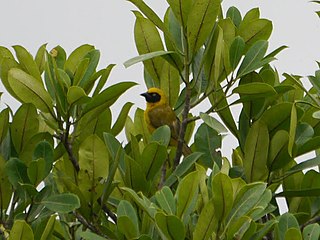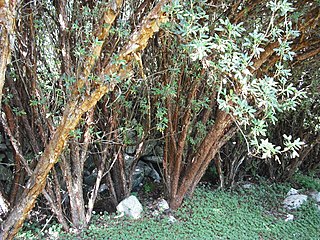
The wrentit is a small bird that lives in chaparral, oak woodlands, and bushland on the western coast of North America. It is the only species in the genus Chamaea.

Bell's vireo is a songbird that migrates between a breeding range in Western North America and a winter range in Central America. It is dull olive-gray above and whitish below. It has a faint white eye ring and faint wing bars.

Baccharis is a genus of perennials and shrubs in the aster family (Asteraceae). They are commonly known as baccharises but sometimes referred to as "brooms", because many members have small thin leaves resembling the true brooms. They are not at all related to these however, but belong to an entirely different lineage of eudicots. B. halimifolia is commonly known as "groundsel bush", however true groundsels are found in the genus Senecio.

Notiosorex cockrumi, also called Cockrum's gray shrew or Cockrum's desert shrew, is a tiny species of shrews named in 2003. This red-toothed shrew, which is as light as a penny, is the first new mammal species from Arizona since 1977. Its range extends from Arizona to central Sonora, Mexico.

Baccharis arbutifolia is a species of flowering plant in the family Asteraceae found only in Ecuador. Its natural habitats are subtropical or tropical moist montane forests and subtropical or tropical high-altitude shrubland.
Baccharis eggersii is a species of flowering plant in the family Asteraceae that is endemic to Ecuador. Its natural habitat is subtropical or tropical dry forests. It is threatened by habitat loss. It may occur in Churute Mangroves Ecological Reserve and Machalilla National Park.
Baccharis fusca is a species of flowering plant in the family Asteraceae that is endemic to Ecuador. Its natural habitat is subtropical or tropical moist montane forests. It is threatened by habitat destruction.
Baccharis hambatensis is a species of flowering plant in the family Asteraceae that is endemic to Ecuador. Its natural habitats are subtropical or tropical moist montane forests and subtropical or tropical high-altitude shrubland. It is threatened by habitat loss.
Baccharis hieronymi is a species of flowering plant in the family Asteraceae. It is found only in Ecuador. It grows in subtropical or tropical moist montane forests and subtropical or tropical high-altitude shrubland. It is threatened by habitat loss.
Baccharis huairacajensis is a species of flowering plant in the family Asteraceae. It is endemic to Ecuador. Its natural habitat is subtropical or tropical moist montane forests. It is threatened by habitat loss.
Baccharis klattii is a species of flowering plant in the family Asteraceae that is endemic to Ecuador. Its natural habitats are subtropical or tropical moist montane forests and subtropical or tropical high-altitude shrubland. It is threatened by habitat loss.

Draba aretioides is a species of flowering plant in the family Brassicaceae. It is found only in Ecuador. Its natural habitat is rocky areas.

The Arizona toad is a species of toad in the family Bufonidae. It is endemic to the south-western United States, where its natural habitats are temperate lowland forests, rivers and streams, swamps, freshwater marshes, freshwater springs, ponds, open excavations, irrigated land, and seasonally flooded agricultural land.

The chestnut-bellied flowerpiercer is a species of bird in the family Thraupidae. It is endemic to Colombia.

Bannerman's weaver is a species of bird in the weaver family, Ploceidae. It is found in Cameroon and Nigeria. Its natural habitat is subtropical or tropical moist montane forests. It is threatened by habitat loss.

Lysipomia aretioides is a species of plant in the family Campanulaceae. It is endemic to Ecuador. Its natural habitats are subtropical or tropical high-altitude shrubland and subtropical or tropical high-altitude grassland. It is threatened by habitat loss.
Oldenlandia aretioides is a species of plant in the family Rubiaceae. It is endemic to Yemen.

Polylepis racemosa is a species of small tree in the family Rosaceae. It is endemic to Peru, Bolivia, and Ecuador. It is threatened by habitat destruction. The International Union for Conservation of Nature has assessed the conservation status of this tree as "vulnerable".
Valeriana aretioides is a species of plant in the family Valerianaceae. It is endemic to Ecuador. Its natural habitat is subtropical or tropical high-altitude grassland.

Baccharis vanessae is a rare California species of Baccharis known by the common name Encinitas baccharis. It is native primarily to San Diego County, California, almost endemic to the county except for one population a few miles over the county line in Riverside County. It is a member of the chaparral flora. It is a federally listed threatened species. It is present in several sites in Encinitas, and it is known from other parts of the county from the coastline to the mountains on various substrates. There are perhaps 15 populations remaining, for a total of about 2000 individuals. Some of the remaining occurrences are on land which may be cleared for development.












